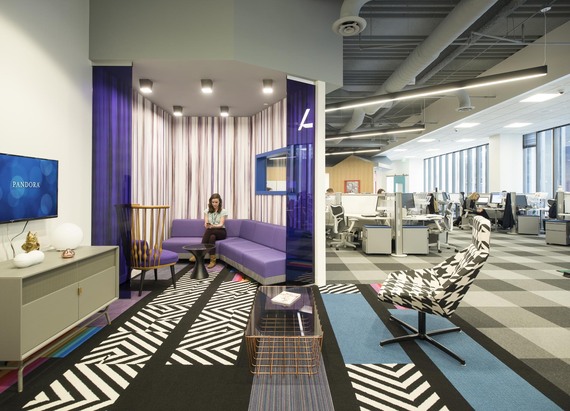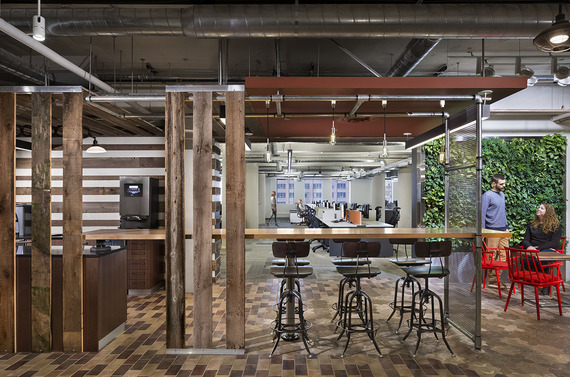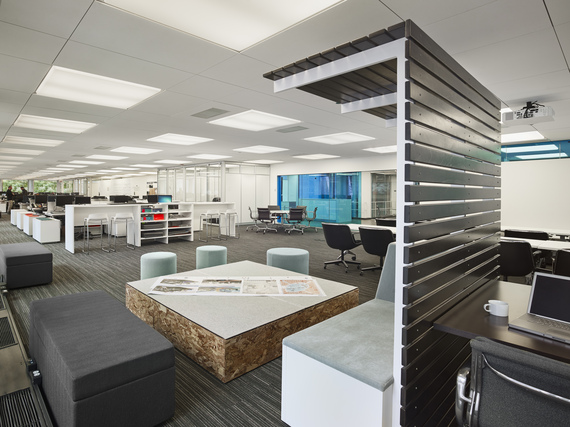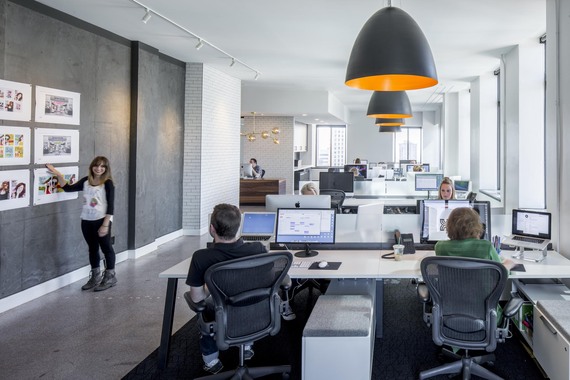Global design and consultancy firm NELSON recently announced their intent to launch a design practice dedicated to TAMI companies (Technology, Advertising, Media, and Information Businesses). You may be thinking, "What a strange convergence?" but the grouping is actually quite smart.
For the past two years, TAMI companies have been the fastest rising star in real estate markets across the country. Responding to the leaps and bounds in technological advances, these companies are converging in not only workstyle and space requirements, but disruptive innovation in their respective industries. Laura Johnson, Director of Marketing says, "Together with the local broker community, our New York office noticed that technology, advertising, media, and information businesses were really looking for same type of spaces and they were all citing the same type of reasons. They wanted unique places that would draw best and brightest unique talent. This included loft spaces outside of traditional areas within the city that could inspire creativity, and high performance spaces with a much more flexible floorplate.
Building upon a solid foundation of working with many well-known tech clients - including Google, Amazon, Oracle, Verizon, and Cisco - and multiple companies in advertising giant Publicis Groupe - including Starcom, Mediavest, Digitas LBi, Leo Burnett, Razorfish, and MSLGroup - NELSON created their new design practice to group and leverage internal expertise around the common desires of these seemingly disparate types of companies. Johnson explains, "One of the things we are seeing in all of these industries is large companies that still manage to keep that young, creative startup mentality. Tech firms are becoming more creative, and creative firms are having to become more focused on technology."
Johnson continues, "On the technology side, history has shown us companies like Hewlett Packard, Dell, and IBM. Now the leading technology companies are much more creative by nature and larger, including the likes of Facebook, Google, and Dropbox. Today's tech companies think, look, and work differently. Conversely, if you look at what's happening in advertising, everything is moving out of the print world and into the technology realm. From print ads to web banner, and even billboards as LED screens, these creative firms are forced to become technology driven."
Over the past five years NELSON has had a natural emergence of leaders for this type of work, including Theresa Williams, LEED AP ID+C, Principal and Design Director in Chicago, and Stacy Chambers, Managing Director in Boston. They, with others, have built the NELSON portfolio allowing dedication of national resources specifically to this kind of project. Mitchell Cohen, Managing Principal says, "Most large competitive firms are regional experts, but not necessarily this granular on these specific types of projects. Anywhere in the country, on a TAMI project, NELSON will have these experts involved to help drive all of the things that make this kind of client unique and come up with the approach and the methodology and philosophy."
NELSON has found that the common denominators for Technology, Advertising, Media, and Information Businesses work spaces are the need for creativity and the desire for smart recruitment and retention, but they also all highly value flexibility and technology integration. While some types of TAMI companies typically grow faster than others, NELSON has recognized that all of these companies are looking for similar resources. However, just because these commonalities drive similar needs does not mean that each company or each type of company solves these challenges the same way. Williams describes their process by saying, "A lot of it is based in ability to come to table, listen to what's different. We can apply what we have learned from other similar clients but in new ways. Our solutions are not off-the-shelf or out of a catalog, and we are not forcing anything that they aren't willing to accept." One example of the biggest differences is that Advertising and Media companies always have client facing spaces, where tech companies don't necessarily need that.
Like many other non-TAMI spaces, activity-based planning is becoming a big part of planning. Williams says, "It's about crafting a menu of spaces that people can choose from all within one workplace. Our job is to use data-driven design to create space where workers know they have all the tools, people, and space needed to do what they need to do during the day. There are zones for noise and activity. Scrumming to individual work. In many of these workplaces it is fast paced, team-based work and the space must accommodate that."
Amenity spaces are also a big part of the design for the TAMI practice. Chambers says, "It's all about developing the unique amenity space and not being repetitive. We must create spaces that allow workers to come together, scrum an idea quickly, then move along to the next personal space or collaborative zone. TAMI spaces must have both amenity rich and unique types of spaces that help their workers be more effective." Each of these workplaces must be a place that people WANT to come, that makes them more effective at work. That is where the recruitment and retention piece comes in.
Today, there's also the coworking space factor. Chambers says, "Sometimes we will encounter a startup that is trying to weigh the options of coworking and creating their own office. Often, for companies below a certain size, financially they will see that going into coworking is the best choice for them right now. Bigger companies breaking into new geographies are also looking at coworking spaces while they establish themselves in new markets. We don't shy away from either of those conversations. When they get to the point they need their own space they come back and engage us."
When asked about the unique furniture planning needs for TAMI companies, the NELSON team cited that aesthetics tend to be slightly different from standard, basic contract furniture selections. Chambers says, "You want quality, there's a budget, and a lot of the larger manufacturers don't offer the fit and finish of these unique furniture pieces and selections that would help to enliven the brand. We end up turning to retail brands on occasion, but there are a lot of challenges with that. So, we tend to go a little more custom; finding local fabricators to make that furniture piece for the right look." Also, although many TAMI companies are not specifically going for LEED certification, for many of them being environmentally responsible is a personal obligation. It's both health and wellness and goodwill toward environment.
With a finger on the pulse of major metropolitan areas across the country, NELSON's launch of a dedicated TAMI practice continues to track the changing needs of this emerging sector. John "Ozzie" Nelson Jr, Chairman and CEO of NELSON, says, "NELSON has been serving the Technology and Advertising & Media sectors individually for close to 40 years. For our tech clients, creativity has become an ingrained part of their cultural DNA. For our advertising and media clients, technology is playing a greater part in their service offering. Combining our design and planning leadership from both worlds means we now have a team of creative powerhouses forging a new path to meet the needs of these companies."
This post originally published in the Bellow Press Business of Furniture on August 24th and can be found at this link. It is republished here with permission.
About the author: Amanda Schneider, LEED AP is a trends researcher, blogger for the Huffington Post, and the founder of Contract Consulting Group, a consulting practice serving the Contract Interiors Industry focused on business strategy, market research and marketing content development.




